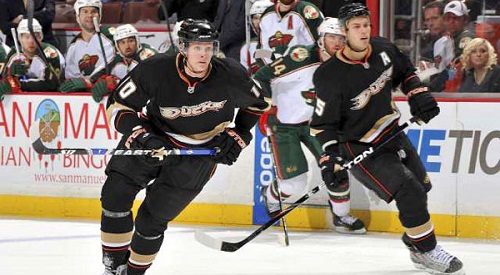
Anaheim Ducks: The Deadline Dilemma
The Anaheim Ducks sit two points from the top of the NHL, yet are in an unenviable position.
Both Ryan Getzlaf and Corey Perry, the team’s two towers of power, are unrestricted free agents on July 1st and the longer they go unsigned the more GM Bob Murray risks losing them both for nothing.
Usually, a team with pending free agents can frantically work to get a deal done during the season, make their best offer, and put the players on the trading block if the deal falls on deaf ears. Starting a massive bidding war at the deadline can bring in a handful of picks and prospects in return for a player, or players, who weren’t likely to stay put long-term.
That’s the only realistic option for bottom-feeders, like Atlanta was back in 2010 when they tried valiantly to re-sign Ilya Kovalchuk, offering him more than $101 million over 12 years. Kovalchuk spurned the offer, maybe because he had an inkling he was going to have a team circumvent the cap to sign him. The Thrashers gave it their best shot, and with no realistic chance of even making the playoffs, the decision to deal the face of the franchise was an easy one.
It stings to lose your best players, especially after robbing a few banks to get the money to pay them, but when you know there’s no chance they are sticking around you can at least turn to Plan B. Atlanta used the first-round pick from the Kovalchuk trade to acquire Dustin Byfuglien, now a key piece in their current lineup.
[php snippet=1]
Teams atop the standings, however, don’t have that same luxury. Contending clubs with soon-to-be free agents must find a way to balance the present (“Let’s win this Stanley Cup!”) and the future (“Hey, why are you selling your house, Zach?”). That’s essentially hockey’s version of Sophie’s Choice. And while it’s all well and good to put all your chips in and make a dash for the Stanley Cup banners do hang forever, after all – the future is pretty bleak if it doesn’t work out. Provided you aren’t New Jersey, of course.
Although teams have the illusion of choice, in reality, making a push for the Stanley Cup is really the only option, especially so for those teams more safely nestled in the playoff picture. Selling your primary stars not only cripples your team, essentially ending your playoff dreams, but kills your fan base as well, most of whom are worried sick about losing the stars to begin with. And with the uncertain nature of picks and prospects (the three players Atlanta received for Kovalchuk were Johnny Oduya, Niclas Bergfors and Patrice Cormier) an endless Islanders-like cycle of rebuilding could await teams that are afraid to lose their talent for nothing.
That’s the situation the Ducks face now. Too good to deal Getzlaf and Perry, but with no assurance of keeping them longer than this season. The deeper into the season the Ducks stay dominant, the more likely Murray is to keep both stars. There is no other choice, even if teams come calling with first-round picks and highly-touted prospects.
If the Ducks start falling, however, Murray’s decision becomes exceedingly difficult. Joe Nieuwendyk and the Dallas Stars gambled by keeping pending free agent Brad Richards at the 2011 trade deadline, and eventually ended up with no playoffs, missing the eighth seed by two points, and more importantly, no Richards, who bolted for New York on July 2nd. Dallas didn’t make the playoffs last year either, and are only one point up on the ninth place team in the West this season.
For the record, neither Getzlaf nor Perry have said anything that suggests they are jumping at the chance to leave Anaheim. In fact, Getzlaf lives in the Anaheim area year-round and is pretty proud of being the captain of the Ducks. However, the closer it gets to free agency the more the pair might be tempted to see what’s out there. And when they realize they soon could be swimming in Scrooge McDuck’s money pool, they might forget all about Anaheim.
[php snippet=1]

